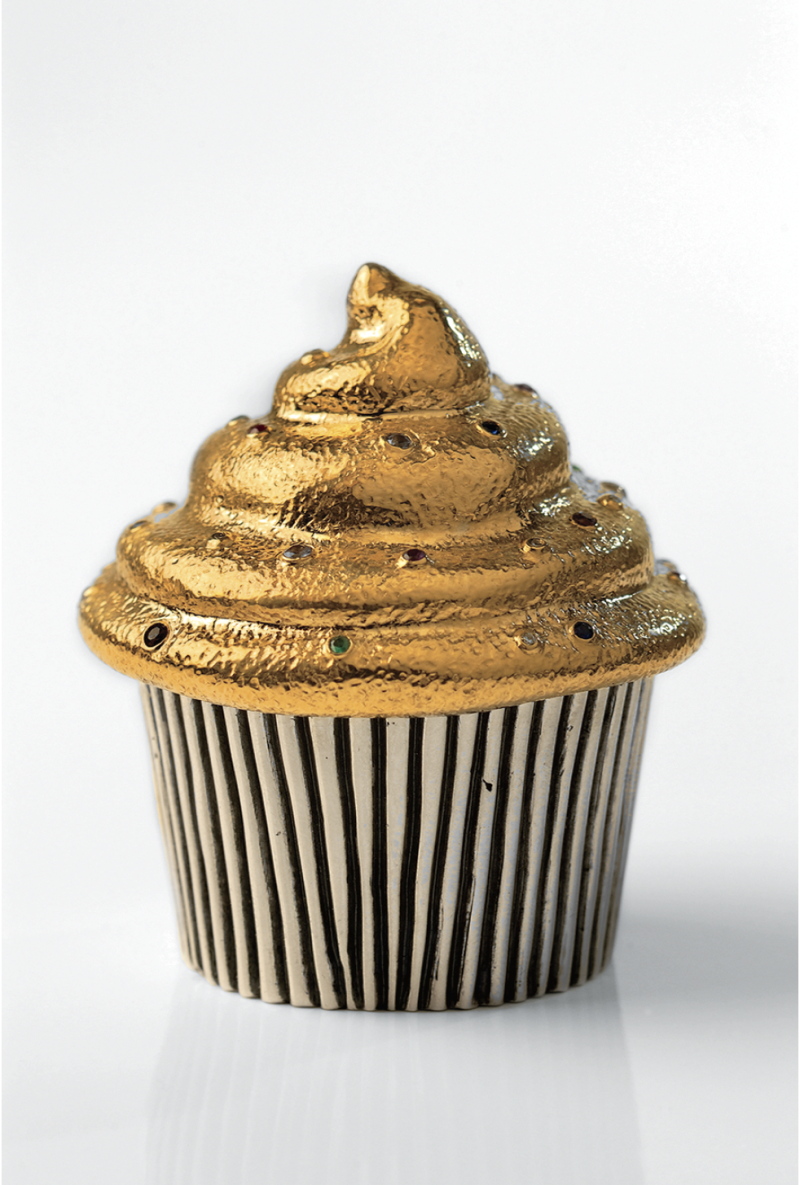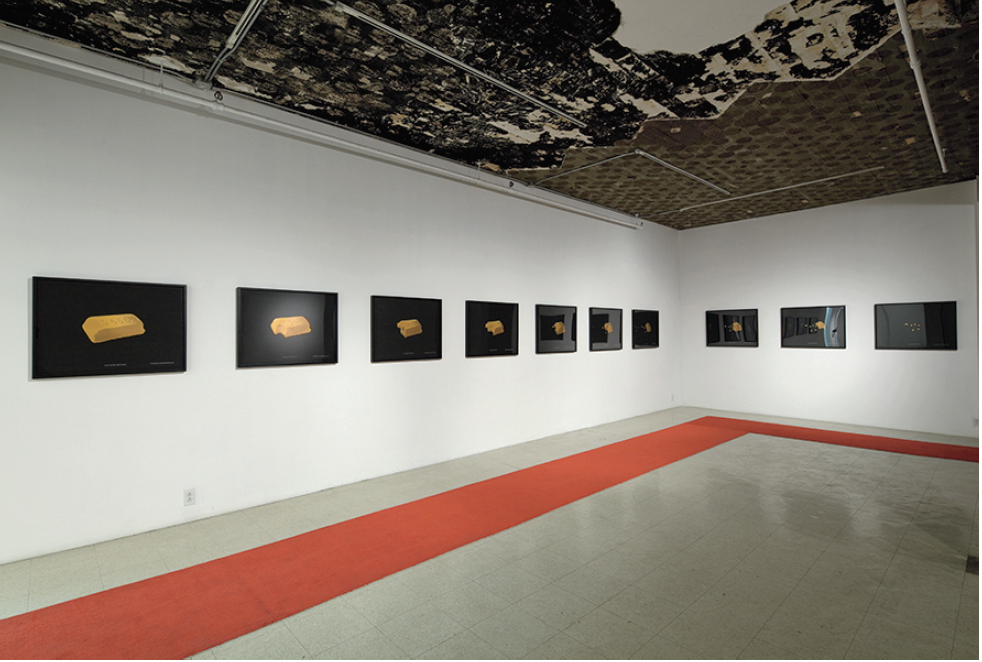Cooke-Sasseville
At first glance, Cooke-Sasseville’s latest installation at Art Mûr appears a snug narrative. Led along on a red carpet, the spectator can enjoy the gentle act of aesthetically consuming a bar of gold held within an image space of 56 by 76 cm. The title, Valeur refuge (safe investment), is a reminder of our sad economic times. Following along the line, breaking right, breaking left then left again, leading into a darkened room, the spectator encounters the means to their own consumptive process: a lovely display case housing a little golden cupcake, Le petit gâteau d’or, adorned with enough jewels and precious stones to make any writer second guess why in God’s name they did not get into art theft, as the pay off would be so much sweeter.

Cooke-Sasseville, The Golden Cupcake, 2010, gold, silver, diamonds, emeralds, rhodolite garnets, rubies, topazes, amethysts, sapphires, 7 x 6 x 6 cm. Photograph: Étienne Boucher. Courtesy Art Mûr, Montreal.
The connotation of sweetness, the soft touch of the cupcake to one’s lips, where one encounters the sensual bliss of confectionary perfection in relation to the golden bite of certainty, is ultimately a pretty great joke. Some may or may not realize the layered coils of humour active in this intimate instant. The sign, removed of its function, casts a shadow of doubt on its purpose. But fear not, because as luxury-handbag designer Judith Leiber has shown, an American tradition brought anew from the censoring of a cell phone connection may guide us along a path of tradition soaked in media saturation.
The Québécois duo Jean-François Cooke and Pierre Sasseville continue a series of conceptual projects driven and grounded in a functional practice that utilizes a myriad of inter-arts techniques. This, their most recent manifestation, “The Golden Cupcake,” attacks not only the art institution but the very weight of the art object itself. Anytime an artist takes up the theme and attention of a precious metal or stone, merely based on the price, people start to pay attention. Between Hirst’s kitschy diamond skull and Koh’s brand of golden dookie, the past five years have seen their share of forays into the lap of luxury. But at what expense? Save for a few of German philosopher Max Stirner’s leftovers, who can theorize the weight of a decentred ego and one’s own? At this juncture, most of us just shrug it off and enjoy the ride into utter depravity and decadence. Really, it becomes a question of reference, how does one accurately recount an exhibition where a series of images display the very act of consuming a bar of gold, to which one is then lead to a golden cupcake adorned with fine and precious jewellery that shares an uncanny resemblance to a pile of shit?
Somewhere between the gift of the Duchampian gesture and the canned excrement of Manzoni—there is a wide range of art historical precedents active in the work—contemporary critical arts practices function in a binary that runs a gamut of severity to outright satire. A potential critical commentary here being the way in which society gives weight to an aesthetic object over the right to sustenance. Alternatively, we could bask in our time of free associations, where Pop culture and general mayhem inhibit historical reference, leaving us to float in a multiplicity of interchangeable reference points. I should add that upon first viewing the beautiful display case that houses this one golden cupcake, I was taken back to a childhood memory of watching The Great Muppet Caper. Likewise, when I went into a cupcake store here in Montreal to find out about the history of this style of cupcake, I was given two very divergent answers. The first: the style comes out of the American tradition, where these kinds of cupcakes were prominent during the ’40s and ’50s, and as such, the pastry chef explained, they are a family tradition handed down. The second answer, a bit more conspicuous but equally valid: they started making the cupcakes again after watching the Sex and the City movie where a lead character had tucked her cell phone into a Leiber purse shaped like a cupcake, and they figured it might be a profitable enterprise.

Cooke-Sasseville, Valeur refuge 1–10, 2010, silkscreen prints, 56.5 x 76 cm each. Photograph: Guy L’Heureux. Courtesy Art Mûr, Montreal.
There you have it, a few ways to view, neither better than any other. Red carpet and all, upon entering the gallery, you will be led along a defined line, you will visually consume a bar of gold without question, and then you will examine the physical reality of that consumption. Yet, the object is encased, not unlike the pictured object housed in those frames just past. A subtle effect of the casing is the multiplicity of cupcakes generated by the act of ownership, the act of possession, perhaps, to remind that the safety of investment, ultimately an act of faith within a capitalist system, is that profit begets more profit, gold begets more gold. Whether illusion, faked or illusive, these realities matter little. What does matter and what Cooke-Sasseville have accomplished with their most recent installation is the belief that an image can create an object. To literally make something from nothing: the 21st-century alchemist’s dream of turning paper to gold. ❚
“The Golden Cupcake” was exhibited at Art Mûr in Montreal from March 6 to April 24, 2010.
Michael Rattray is a PhD student, curator and writer based in Montreal.

